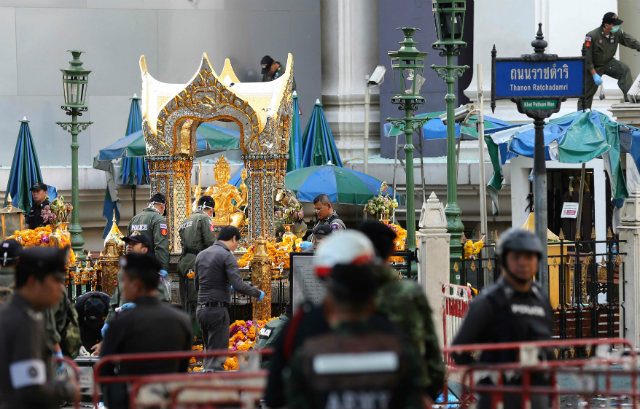SUMMARY
This is AI generated summarization, which may have errors. For context, always refer to the full article.

BANGKOK, Thailand – Thai authorities said Wednesday, August 19, the man who carried out a devastating Bangkok shrine bombing that killed 20 people was a foreigner and part of a network.
The attack occurred on Monday, August 17, as worshippers crowded into the Hindu shrine in the Thai capital, shredding bodies and incinerating motorcycles. A majority of the victims were Asian tourists.
Police on Wednesday released a sketch of a young man shown on security footage walking into the shrine and placing a backpack believed to contain the bomb, which detonated a few minutes later.
A few hours after the sketch was released, a Bangkok court issued an arrest warrant for the man depicted, describing him as a tall foreigner with white skin.
The warrant accused the “unnamed foreigner of premeditated murder, attempted murder and bomb-making.”
Before the arrest warrant was made public, national police chief General Somyot Poompanmoung told reporters a “network” had orchestrated the attack, which has no precedent in the Thai capital.
The bombing claimed the lives of at least 13 foreigners – from China, Hong Kong, Britain, Indonesia, Singapore, and Malaysia.
Another 68 people remained in hospital on Wednesday, 12 of whom were in critical conditions.
New clues
The police sketch of the suspected bomber showed him with black-rimmed glasses, a full head of dark hair and a light complexion.
Police spokesman Prawut Thavornsiri said his features were gleaned partly from security footage taken of him at the shrine in the minutes before the attack.
He said the profile had also used information gathered from interviews with the drivers of the motorcycle taxis that the suspect used to arrive at the shrine and leave it.
Motorcycle taxis are a common form of transport in Bangkok.
The security footage, released to the public on Tuesday, showed the suspect wearing a bright yellow T-shirt and dark shorts, walking into the shrine with a backpack.
He casually placed the backpack underneath a bench and then slowly walked away clutching a blue plastic bag while looking at what appeared to be a smartphone.
Police said he escaped on a motorcycle taxi a few minutes before the blast.
Police spokesman Prawut said Wednesday there were “at least two” others men at the shrine who may have been involved.
He said they were seen on the security footage close to the suspect as he slid his backpack under the bench, and may have been deliberately shielding him from passers-by.
Police on Wednesday offered a 1 million baht ($28,000) reward for information that leads to the arrest of the main suspect.
Security fears
Police had initially said a second explosion at a Bangkok pier on Tuesday that caused no injuries may also be linked, deepening fears for residents of their safety.
On Wednesday, Somyot said the second attack might also be a “copycat” although police were keeping all options open.
Security experts had previously said they were baffled over who was responsible.
Thailand has experienced a near-decade-long political crisis that has seen endless rounds of street violence.
But it has never seen anything on the scale of Monday’s bomb and foreigners are generally not targets in a country that prides itself on extending a warm welcome to outsiders.
A festering insurgency by Muslim rebels in the Thai south has claimed 6,400 victims – the majority civilians – but it is a highly localized conflict.
Foreign suspicions
The arrest warrant announced on Wednesday raised questions over which foreign groups had the motives and capabilities to carry out the attack.
The Islamic State group, which has caused carnage in the Middle East, is not known to have carried out any attacks in Southeast Asia.
Some Thai media outlets had cast suspicion on militants from China’s Uighur minority, a group that faces cultural and religious repression in its homeland.
Chinese authorities have blamed Uighurs for a series of attacks inside China, most of which have been knife assaults.
Last month, Thailand forcibly repatriated more than 100 Uighur refugees to China, and some Thai media speculated that Monday’s attack may have been an act of revenge.
The Erawan shrine is close to Bangkok’s Chinatown and Chinese tourists are among the most important for Thailand.
Five of the confirmed fatalities were from China, and another two were from Hong Kong.
But Uighur groups are not known to have ever carried out an attack outside of China.
Various Islamic militant groups have also carried out many attacks in other parts of Southeast Asia, including bombings on Indonesia’s holiday island of Bali in 2002 that killed 202 people.
But they have not previously made Thailand a prime target.
The shrine, a popular tourist attraction that typifies the kingdom’s unusual blend of Hindu and Buddhist traditions, reopened on Wednesday morning with a ceremony led by chanting monks.
Its surroundings had been largely restored and the pools of congealed blood scrubbed away.
Twisted iron railings were the only immediate sign of the blast point, which police believe was caused by a bomb made up of 3 kilograms of high explosives. – Jerome Taylor, AFP / Rappler.com
Add a comment
How does this make you feel?
There are no comments yet. Add your comment to start the conversation.